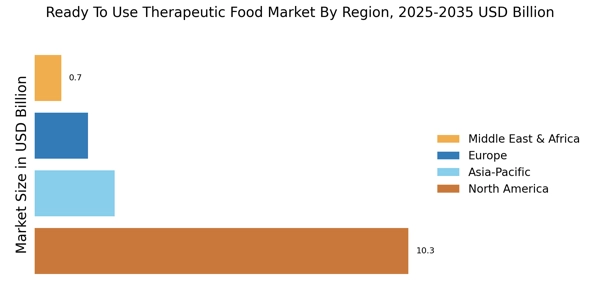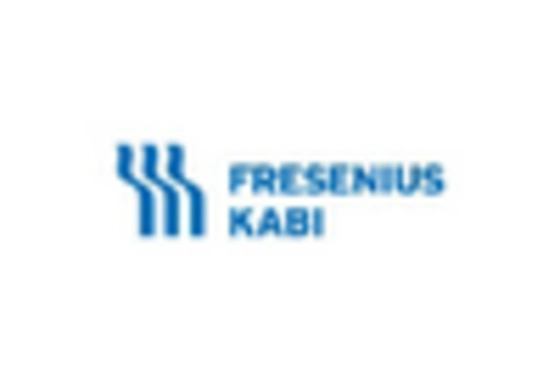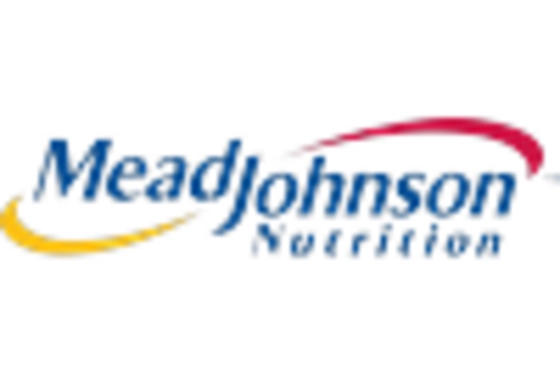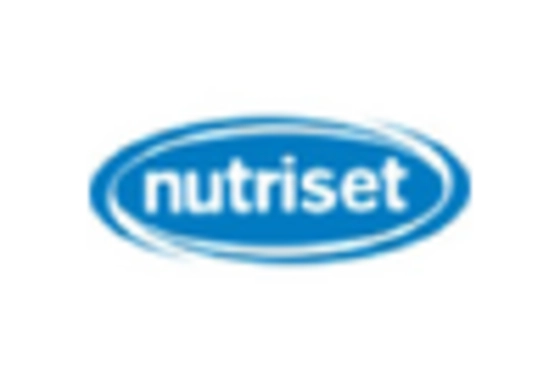Rising Prevalence of Malnutrition
The rising prevalence of malnutrition, particularly among vulnerable populations such as children and the elderly, appears to be a significant driver for the Ready To Use Therapeutic Food Market. According to recent data, malnutrition affects millions worldwide, leading to increased demand for effective nutritional solutions. The Ready To Use Therapeutic Food Market is positioned to address this issue by providing nutrient-dense products that can be easily consumed and absorbed. This trend is likely to continue as governments and organizations prioritize nutritional interventions to combat malnutrition, thereby expanding the market for therapeutic foods. Furthermore, the increasing awareness of the long-term health consequences of malnutrition may further propel the demand for ready-to-use therapeutic foods, as stakeholders seek to implement preventive measures.
Government Initiatives and Support
Government initiatives and support for nutritional programs are likely to play a crucial role in the growth of the Ready To Use Therapeutic Food Market. Various countries have implemented policies aimed at reducing malnutrition and improving food security, which often include the distribution of therapeutic foods. For instance, funding for programs that provide ready-to-use therapeutic foods to at-risk populations has been on the rise, indicating a commitment to addressing nutritional deficiencies. This support not only enhances the visibility of the Ready To Use Therapeutic Food Market but also encourages private sector investment in the development and distribution of these products. As governments continue to recognize the importance of nutrition in public health, the market for ready-to-use therapeutic foods is expected to expand significantly.
Growing Demand for Convenience Foods
The growing demand for convenience foods is a notable driver for the Ready To Use Therapeutic Food Market. As lifestyles become increasingly fast-paced, consumers are seeking quick and easy meal solutions that do not compromise on nutrition. Ready-to-use therapeutic foods offer a practical solution for individuals and families looking for nutritious options that can be consumed on the go. This trend is particularly relevant for caregivers and healthcare providers who require efficient feeding solutions for patients and vulnerable populations. Market analysis indicates that the convenience factor is likely to continue influencing consumer choices, thereby propelling the growth of the Ready To Use Therapeutic Food Market as it aligns with the evolving preferences of modern consumers.
Increased Awareness of Nutritional Health
Increased awareness of nutritional health among consumers is emerging as a pivotal driver for the Ready To Use Therapeutic Food Market. As individuals become more informed about the impact of nutrition on overall health, there is a growing demand for products that offer specific health benefits. This trend is particularly evident in the rising interest in functional foods, which are designed to provide health benefits beyond basic nutrition. The Ready To Use Therapeutic Food Market is well-positioned to capitalize on this trend, as these products are formulated to meet the nutritional needs of specific populations. Market data suggests that the demand for therapeutic foods is likely to grow as consumers seek convenient and effective solutions to enhance their health and well-being.
Technological Innovations in Food Production
Technological innovations in food production are likely to enhance the efficiency and quality of products within the Ready To Use Therapeutic Food Market. Advances in food processing technologies, such as improved preservation methods and nutrient retention techniques, are enabling manufacturers to create more effective therapeutic foods. These innovations not only improve the shelf life of products but also ensure that they retain their nutritional value. As a result, the Ready To Use Therapeutic Food Market is expected to benefit from increased consumer trust and satisfaction. Furthermore, the integration of technology in production processes may lead to cost reductions, making therapeutic foods more accessible to a broader audience, thereby driving market growth.


















Leave a Comment